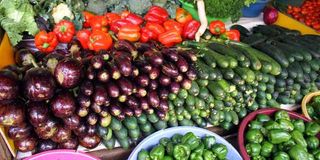Premium
Crop expert: How to get good cucumber yields and identify chemicals on fruit

Vegetables at a stall in Kangemi Market, Nairobi.
Joan Wangeci
Cucumbers will do well in Nyeri County. They can do well in an open field and greenhouse as they are warm season crops that are grown for their immature fruits.
Cucumber varieties include Carmen F1, palomer, woodland crisp, Colorado, poisette, hybrid victory, danora F1, early fortune, Jude F1, prince F1, asher F1, envoy F1, snow-white F1 and yellow fellow.
Some varieties are suitable for open field production while others are for greenhouse.
Cucumber will do well in altitudes of up to 1,700 metres above sea level and annual optimum rainfall of 800mm.
Temperature range is 18 to 30 degrees Celsius. The soil should be well-drained with a pH of 6.5-7.5.
Cucumbers are propagated from seeds, which are directly planted in the main bed. Spacing is 1.5 to 2.5 metres between rows and 60-90cm within the rows.
When planting, you can mix 15 tonnes of organic manure with 200 kilogrammes of DAP per hectare.
Topdressing is done when plants attain a height of 15cm using CAN at a rate of 100kg per hectare.
To maintain soil moisture, it is advisable to irrigate your cucumbers. Drip irrigation is recommended in a greenhouse.
Mulching conserves soil moisture, suppresses weeds and increases soil fertility. Organic mulch is preferred.
Keep the field weed-free throughout the growing period. Note that some weeds act as hosts for pests or diseases.
You have to support the cucumbers in the greenhouse by trellising.
Pruning ensures balance between vegetative growth and fruit production. Pruning is by removal of shoots, leaves, flowers and even the fruits. With little or no pruning, the fruits will be shaded and will not develop a good colour.
The most common pests are thrips, white flies, fruit flies, red spider mites, leaf miners, cutworms, root knot nematodes and epilachna beetles.
The pests can be controlled using appropriate chemicals or biopesticides.
Cucumber diseases include damping off, downey mildew, anthracnose, angular leaf spot, fusarium wilt, cucumber mosaic and powdery mildew.
Harvesting starts 50 to 60 days after planting, depending on the variety and ecological conditions. Cucumbers should be picked early when they are deep green in colour and still immature.
Carol Mutua
Crop Production Specialist
Identifying chemical residues on fruits
Hello Seeds of Gold crop expert, I have become sensitive on what I eat, especially after witnessing the use of herbicides and pesticides on fruit and vegetable farms countrywide. How does one tell the amount of chemical residues on tomatoes, cabbages, spinach and fruits bought at a market?
After witnessing what farmers do when growing these things, I came to realise that many rarely use the correct amounts of chemicals, over-spray or under-spray. Are there gadgets that can determine the chemical residues in food at home? If not, how do I ensure my food is free from these pesticides before consumption? Is washing the food thoroughly enough to make it safe for all?
Anthony Ambaza,
Malaba, Busia County
Thank you very much Anthony for your question. Most people are concerned about chemical residues after seeing the inputs being used in farming.
Unfortunately, you cannot tell if there are pesticide residues on fruits or vegetables because the residues are invisible, odourless and tasteless. Therefore, visual inspection cannot be used to tell whether a fruit or vegetable is safe.
I agree with you that some farmers do not use the correct amounts of these chemicals and some over spray the herbicides and pesticides while others harvest produce before the pre-harvest interval is over.
There are pesticide test kits but are for testing specific chemicals in produce. The best option would be to take your samples to an accredited food laboratory for pesticide residue analyses.
Washing fruits and vegetables can significantly reduce surface pesticide residue but it does not completely remove the residue.
You can wash your fruits/ vegetables by rinsing under running water to remove surface residues, dirt or dust bound pesticides.
You can also peel your fruits/vegetables like apples, carrots or cucumbers, and blanching leafy vegetables.
Wiping or rinsing quickly will not help remove chemical residues. In addition, washing with soap or detergent may be harmful when eaten.
To ensure that you consume pesticide-free fruits, vegetables and other food, you can buy organically produced fruits and vegetables or grow your own.
You can also buy from farmers you trust.
Enlighten your fellow farmers on the need for integrated pest management to reduce the use of chemical pesticides and herbicides.
Carol Mutua
Crop Production Expert

